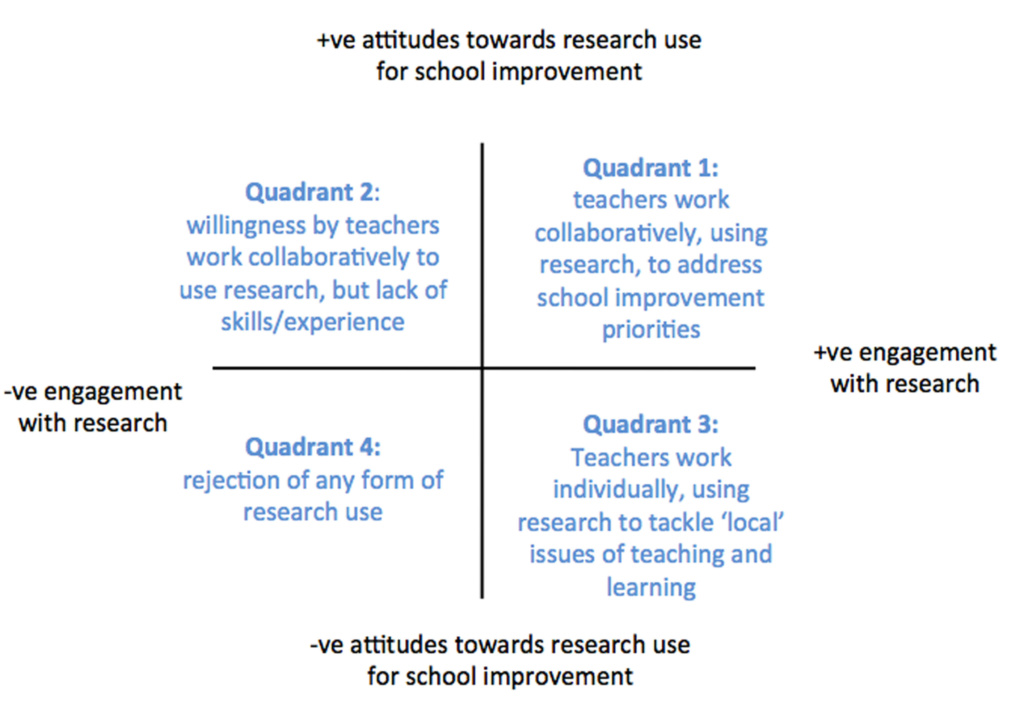
What can be done to foster positive attitudes towards, and engagement in, research by teachers so that this increased “research capital” can in turn result in improvement dividends? This ambition is explored in this article and illustrated through a case study of three schools working together within the Chestnut Learning Federation.
Evidence informed practice
Evidence informed practice (EIP) is defined by England’s Department for Education as: ‘A combination of practitioner expertise and knowledge of the best external research, and evaluation-based evidence’ (www.education.gov.uk). Despite ongoing controversies and debates (e.g. Hargreaves, 1996; Goldacre, 2013) a swathe of education policy in England now heavily emphasizes teachers’ use of research evidence as a means to improve teaching and learning (e.g. Department for Education, 2010; Greany, 2015). It is also suggested (e.g. OECD, 2016) that optimal forms of EIP involve teachers collaborating to use research to address school priorities, where these priorities coincide with the day to day realities of the classroom (e.g. teachers’ use of research to improve pupil behaviour or pedagogy). However, little research has been undertaken into how this optimal situation can be achieved (Cain, 2015).
Types of teacher evidence use and ‘research capital’
Recent studies examining the use of research by teachers (e.g. Brown and Zhang, 2016; Stoll and Brown, 2015) suggest that it is possible to characterize teachers’ EIP behaviours according to a combination of their attitudes towards using research for school improvement and teachers’ engagement with research. Conceiving teachers’ research-use attitudes and engagement as forming the axes of a 2 x 2 matrix (see Figure 1), these studies point towards four evidence-use ‘types’: with type 1 use representing teachers working collaboratively using research to address school improvement priorities; type 2 use teachers are those willing to work collaboratively to engage with research, but who lack the skills/experience required; type 3 teachers are those who work individually, using research to tackle ‘local’ issues of teaching and learning; and finally, type 4 teachers reject any form of research use.
Drawing on the idea of other forms of capital such as social and cultural capital (e.g. Boudieu, 1986), I suggest that the notion of research capital (RC) corresponds to situations in which teachers can use research to improve teaching and learning, and where they also seek to do so collaboratively. Linked to this it also follows that securing higher levels of research capital should be what schools should strive to achieve. This means, in terms of school and school system improvement, it would seem preferable for schools to have a high number of teachers who are type 1 evidence users. It is also clear that, based on their attitudes and experience, if type 1 teachers have the highest levels of research capital, then type 4 teachers have the lowest; with type 2 and type 3 teachers possessing intermediate levels of RC. Ideally then, schools that are seeking to be research engaged should be attempting to foster type 1 behaviour amongst their entire teaching staff. As yet, however, no research has been undertaken into whether individual schools tend to have a predominance of teachers of any given type, why this might be the case and how levels of research capital can be raised.

The research informing this article examines these four evidence-use types in more detail to ascertain what leads to teachers possessing higher or lower levels of research capital. It also examines the distribution of teachers by quadrant in one school Federation in Hampshire. The article concludes with suggestions for how this Federation, as well as schools more generally, can work towards developing higher levels of RC and the strategies school leaders might use to develop teachers into type 1 research users.
Chestnut Learning Federation: seeking to become research engaged
The Chestnut CE Learning Federation is a family of three small Church Infant Schools based in the Hampshire villages of Rosebush, All Saints and Southampton Common, who all work closely together under the leadership of the Federation Headteacher and Governing Body (the names of the federation and schools have been changed to preserve their anonymity). The vision of the three schools is to ensure children grow up to lead safe, happy, healthy and successful lives by providing the highest standard of education and the opportunity for each child to attain their own, full potential. One of the Federation’s improvement plan objectives is for it to become an evidence-informed Federation. This would entail schools collaborating to rigorously review the quality of the education they offer, understand what they need to do to improve, take appropriate evidence-informed action and evaluate the impact of their actions. In this way they would adopt an evidenced informed approach to tackling achievement together.